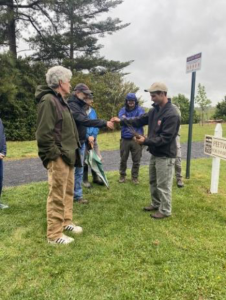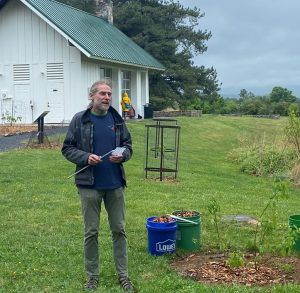2023 Tree of the Year at Blandy Experimental Farm

ALLEGHENY SERVICEBERRY (AMELANCHIER LAEVIS), NAMED 2023 TREE OF THE YEAR
Representatives from the State Arboretum of Virginia at Blandy Experimental Farm have named the Allegheny serviceberry (Amelanchier laevis) as the 2023 Tree of the Year. The Arboretum’s 2023 Tree of the Year was selected after deliberation by Curator T’ai Roulston and Blandy arborists. Since 2019, the State Arboretum of Virginia has designated one extraordinary species of tree as its Tree of
the Year.

In honor of Arbor Day, “the nation’s tree planting holiday,” Blandy arborists and representatives from the Department of Forestry planted an Allegheny Serviceberry tree at the Arboretum on Friday, April 28. The tree was added to a tree and shrub collection that dates to the 1930s. “A vital part of our mission is to practice and promote tree education, science, and conservation,” said Roulston. “Through research and public programming, we want to share with everyone – of all ages – how important trees are to the environment.

Four-season Interest
The Allegheny serviceberry, found native in Virginia, was chosen for its four-season interest, according to Roulston. A small understory tree, it’s ideal for landscapes and grows to only 15-25 feet tall. The Allegheny serviceberry is one of the first trees at the arboretum to flower each spring when the delicate masses of white, fragrant flowers appear in mid-April. Small, dark purple berry-like fruit arrives in the summer. Also commonly known as juneberries, the edible berries attract pollinators and are a food source for native bees and more than 40 species of birds. The fall foliage of the Allegheny serviceberry, when the leaves turn an orange-red color, is outstanding as well. The tree’s attractive gray bark lends structure to the winter garden.
“Juneberries” Serves as Food Source for Wildlife, Humans
Native Americans would dry juneberries, similar in size and taste to blueberries, and mix them with meat to create a high-energy snack called pemmican. Recipes for juneberry pies and jams are easy to find. If you want to eat the berries, though, you’d better be fast. Birds, squirrels, and other wildlife also enjoy the fruit.
How the Allegheny Serviceberry Gets Its Name
For settlers in the colder climates of North America, the blooming of the serviceberry was a sign that the ground was thawing. Graves could now be dug for loved ones who had died during the cold winter months and burial “services” could commence. In some areas, the serviceberry is called shadbush or shadblow. The tree got this name because it blooms around the same time that shad return to their spawning grounds in freshwater rivers and streams. Common names also include smooth shadbush, juneberry and shadberry.


